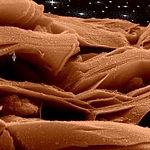

Nanovoices
& Ambassadors
Stories behind the nanoart
Image credit:: José Manuel Martínez López, NanoArtography 2022
What is nanoVoice?
NanoVoices is a blog series that captures the personal stories, inspirations, and reflections of past NanoArtography winners—highlighting the human side of scientific discovery and the art hidden within the nanoscale.
2025 Ambassadors
Meet our 2025 ambassadors, who are active participants and advocates of the competition, and in addition to participation, they volunteered to teach others how to turn their research into art pieces and promote the beauty of the nanoworld.

Juana Yesenia Ramos Martínez
Center for Research and Advanced Studies of the National Polytechnic Institute, Mexico
NanoArtography 2024 finalist

Chinmayee Chowde Gowda
University of Modena and Reggio Emilia, Italy
NanoArtography 2024 finalist

Prachi Rajput
CSIR-CSIO, Chandigarh, India
NanoArtography 2024 finalist
.jpg)
Isabel Sánchez Almazo
University of Granada, Spain
NanoArtography 2024 winner

Anyesha Chakraborty
Indian Institute of Technology Kharagpur, India
NanoArtography 2024 finalist

Veronica Alexandra Quilumba Dutan
Instituto Potosino de Investigación Científica y Tecnológica, Mexico
NanoArtography 2024 finalist
Meet the Artists behinD the lens!
"Winning NanoArtography has brought recognition to our research and outreach visibility at the university and national levels"
IsAbel SÀnchez almazo
Winner
Current Affiliation : University of Granada
Current Role/Title : Ph.D.
E-mail : sanchez@ugr.es
What did winning NanoArtography mean to you, and how has it impacted your confidence, career, or professional opportunities in scientific imaging and communication?
NANOARTOGRAPHY is a contest with great international impact. We have followed it for years but never dared to participate, until now.
Winning has brought recognition to our professional work and to the outreach and artistic side of our efforts, both at our university and even nationally. The Geological Society of Spain has recently requested some of our images to be used as awards for various achievements. We have also submitted several images to a temporary exhibition at the Spanish Museum of Science and Technology.
From a professional perspective, this recognition highlights our contribution to science communication through visual media. We have also taken part in public science events such as Pint of Science. This experience has given us greater confidence in our work and in ourselves.

"Winning NanoArtography was one of my highest achievements in aesthetic photomicroscopy."

Bernardo cesare
Winner
Current Affiliation : Department of Geosciences, University of Padova, Italy
Current Role/Title : Professor, PhD
E-mail : info@microckscopica.org
What tools or techniques did you find most helpful, and how did you overcome any challenges during the creation of your image?
The key to obtaining a winning image was a good microscope and patience, as the drop of Aperol took some weeks on the glass slide before the sugar in it crystallized. Another challenge is the depth of focus, minimal with this technique. It can be overcome by focus stacking, but in this case it was not necesary
What did winning NanoArtography mean to you, and how has it impacted your confidence, career, or professional opportunities in scientific imaging and communication?
Winning NanoArtography was one of my highest achievements in aesthetic photomicroscopy, and has strenghtened my confidence and my search for obtaining more and more beautiful photomicrographs.
"Yes, I've been fortunate enough to leverage my NanoArtography win in several meaningful ways"
kampara roopa kishore
Winner
Current Affiliation : INL-International Iberian Nanotechnology Laboratory, BRAGA
Current Role/Title : Postdoctoral Researcher
E-mail : KISSHORE18@GMAIL.COM
Have you leveraged your NanoArtography win in any unique way, such as in publications, outreach, collaborations or with family and friends?
Yes, I’ve been fortunate to leverage my NanoArtography win in several meaningful ways. Academically, I highlighted the achievement in my research publications and CV, which added a unique dimension to my scientific profile and helped demonstrate my ability to communicate science creatively. This distinction also played a role in securing collaborative opportunities with researchers who appreciated the fusion of science and visual storytelling.
In terms of outreach, I’ve used the experience to engage with students and the broader public during seminars and science communication events, emphasizing how art can make complex scientific concepts more accessible and engaging. It was especially rewarding to see young students become curious about microscopy and nanoscience through visual art.
On a personal level, sharing the award with family and friends was a proud moment. They found it easier to connect with my research through the visual impact of the images. It opened up conversations that normally wouldn’t happen around technical scientific work, making my research feel more inclusive and relatable.
